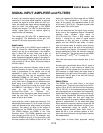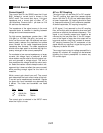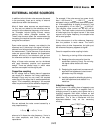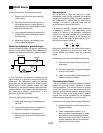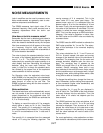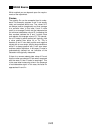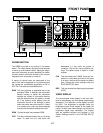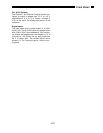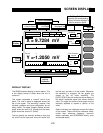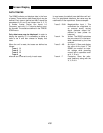
3-27
SR850 Basics
Lock-in amplifiers can be used to measure noise.
Noise measurements are generally used to char-
acterize components and detectors.
The SR850 measures input signal noise AT the
reference frequency. Many noise sources have a
frequency dependence which the lock-in can
measure.
How does a lock-in measure noise?
Remember that the lock-in detects signals close to
the reference frequency. How close? Input signals
within the detection bandwidth set by the low pass
filter time constant and roll-off appear at the output
at a frequency f=f
sig
-f
ref
. Input noise near f
ref
appears as noise at the output with a bandwidth of
DC to the detection bandwidth.
The noise is simply the standard deviation (root of
the mean of the squared deviations)of the meas-
ured X, Y or R . The SR850 can measure this
noise exactly by recording the output quantity on a
chart display and then calculating the standard
deviation using the trace math functions. The
noise, in Volts/√Hz, is simply the standard devia-
tion divided by the square root of the equivalent
noise bandwidth of the time constant.
For Gaussian noise, the equivalent noise band-
width (ENBW) of a low pass filter is the bandwidth
of the perfect rectangular filter which passes the
same amount of noise as the real filter. The
ENBW is displayed along with the time constant in
the GAIN/TC menu.
Noise estimation
The above technique, while mathematically sound,
can not provide a real time output or an analog
output proportional to the measured noise. For
these measurements, the SR850 can estimate the
X, Y or R noise directly.
To display or record the noise of X, for example,
simply define a trace as Xn (in the Trace/Scan
menu). The quantity Xn is computed in real time
and is an estimate of the noise of X. The quantities
Yn and Rn are estimations of the Y noise and R
noise.
The quantity Xn is computed from the measured
values of X using the following algorithm. The
NOISE MEASUREMENTS
moving average of X is computed. This is the
mean value of X over some past history. The
present mean value of X is subtracted from the
present value of X to find the deviation of X from
the mean. Finally, the moving average of the abso-
lute value of the deviations is calculated. This cal-
culation is called the mean average deviation or
MAD. This is not the same as an RMS calculation.
However, if the noise is Gaussian in nature, then
the RMS noise and the MAD noise are related by
a constant factor.
The SR850 uses the MAD method to estimate the
RMS noise quantities Xn, Yn and Rn. The advan-
tage of this technique is its numerical simplicity
and speed.
The noise calculations for X, Y and R occur at
512 Hz. At each sample, the mean and moving
average of the absolute value of the deviations is
calculated. The averaging time (for the mean and
average deviation) depends upon the time con-
stant. The averaging time is selected by the
SR850 and ranges from 10 to 80 times the time
constant. Shorter averaging times yield a very
poor estimate of the noise (the mean varies rapidly
and the deviations are not averaged well). Longer
averaging times, while yielding better results, take
a long time to settle to a steady answer.
To change the settling time, change the time con-
stant. Remember, shorter settling times use small-
er time constants (higher noise bandwidths) and
yield noisier noise estimates.
The quantities Xn, Yn and Rn are displayed in
units of Volts/√Hz. The ENBW of the time constant
is already factored into the calculation. Thus, the
mean value of Xn should not depend upon the
time constant.
The SR850 performs the noise calculations all of
the time, whether or not Xn, Yn or Rn are being
recorded or displayed. Thus, as soon as Xn is dis-
played, the value shown is up to date and no set-
tling time is required. If the sensitivity is changed,
then the noise estimate will need to settle to the
correct value.
For most applications, noise estimation and stan-
dard deviation calculations yield the same answer.



